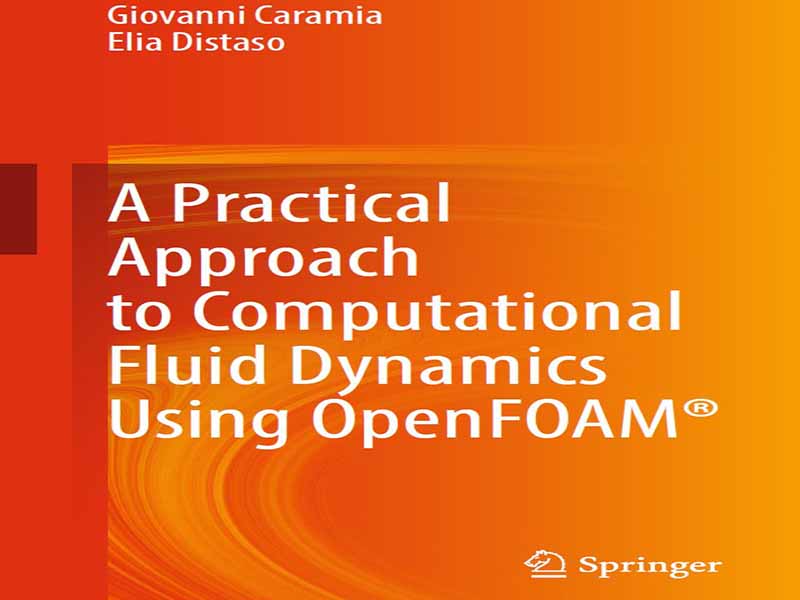- عنوان کتاب: A Practical Approach to Computational Fluid Dynamics Using OpenFOAM
- نویسنده: Giovanni Caramia Elia Distaso
- حوزه: دینامیک سیالات
- سال انتشار: 2025
- تعداد صفحه: 290
- زبان اصلی: انگلیسی
- نوع فایل: pdf
- حجم فایل: 6.16 مگابایت
با این امید که این کتاب منبع ارزشمندی برای تدریس و یادگیری باشد، برای دانشجویان کارشناسی و کارشناسی ارشد مهندسی طراحی شده است که برای اولین بار دینامیک سیالات محاسباتی را به عنوان ابزاری برای تجزیه و تحلیل ماشینها و دستگاههای سیال بررسی میکنند. هدف اصلی تسهیل یک فرآیند یادگیری تدریجی و مؤثر است که به طور قابل توجهی زمان لازم برای کسب حداقل سطح دانش لازم برای تولید نتایج قابل قبول برای اکثر مطالعات موردی مورد علاقه عمومی را کاهش میدهد. برای کسب بینشهای دقیق، خوانندگان به متون ذکر شده در کتابشناسی – و منابع کتابشناسی موجود در آن – ارجاع داده میشوند که خواندن و درک آنها قطعاً پس از آشنایی با مطالب ارائه شده در اینجا سادهتر خواهد بود. برای اطمینان از اینکه مباحث مطرح شده هم جالب و هم قابل فهم هستند، نویسندگان در موارد خاص، وضوح بیان را بر دقت ریاضی اولویت دادهاند و به طور مداوم به معنای فیزیکی فرمولهای ریاضی مورد نظر اشاره کردهاند. محققان و مهندسان همچنین در این کتاب مجموعهای از مفاهیم اساسی ضروری برای پیکربندی صحیح هر نرمافزار شبیهسازی دینامیک سیالات را خواهند یافت. برای اینکه خوانندگان بیشتری بتوانند محتوای ارائه شده در این جلد را به کار گیرند، نویسندگان تصمیم گرفتهاند بر نرمافزار رایگان و متنباز OpenFOAM® تمرکز کنند که توسط جامعهای بزرگ و پویا از توسعهدهندگان و کاربران پشتیبانی میشود. با این حال، به دشواری دسترسی و استفاده از کتابچههای راهنمای مرتبط توجه کنید؛ این جلد نتیجه تحقیقات دقیق و جمعآوری اطلاعات پراکنده در منابع متعدد، از جمله کتابها، مقالات دانشگاهی، یادداشتهای چندرسانهای منتشر شده آنلاین، انجمنهای تخصصی و موارد دیگر است. بخش اولیه این متن (فصل 1) با هدف ارائه ابزارهای لازم برای کسانی است که مایل به انجام تحلیل دینامیک سیالات با استفاده از روشهای حجم محدود برای سیستمهای پیچیده مانند ماشینهای سیال هستند. پس از آن مقدمهای بر معادلات حاکم اصلی دینامیک سیالات (فصل 2) آمده است که هسته اصلی توصیف فیزیکی مسائل عملی مورد مطالعه را تشکیل میدهند. سپس شرحی گسترده اما کاربردی از رویکرد حجم محدود ارائه میشود که با شرح روشهای اصلی گسستهسازی (فصل 3) شروع میشود، به روشهای عددی مورد استفاده برای حل دستگاههای معادلات تولید شده در این فرآیندها (فصل 4) میپردازد و با مسائل کوپلینگ فشار-سرعت (فصل 5) به پایان میرسد. پس از کسب دانش لازم برای انجام تحلیل موردی عملی، کد محاسباتی OpenFOAM® (فصل 6) معرفی میشود و ساختار و پتانسیل آن از طریق مثالهای عملی از تنظیمات شرح داده میشود. این کتاب با بحثی در مورد مسائل مربوط به تنظیم شرایط مرزی در موارد مختلف (فصل 7) و مسئله بسته شدن آشفتگی (فصل 8) به پایان میرسد.
In the hope that it will prove to be a valuable resource for both teaching and learning, this volume is designed for undergraduate and graduate students in Engineering who are exploring computational fluid dynamics for the first time as a tool for analysing fluid machines and devices. The main objective is to facilitate a gradual and effective learning process, significantly reducing the time needed to acquire the minimum level of knowledge required to produce acceptable results for most general interest case studies. For detailed insights, readers are referred to the texts cited in the bibliography—and the bibliographic references contained therein—whose reading and understanding will certainly be more straightforward once familiarity with the material presented here is gained. To ensure the topics covered are both interesting and comprehensible, the authors have, in certain cases, prioritised clarity of exposition over mathematical rigour, continuously referring to the physical meaning of the mathematical formulas considered. Researchers and engineers will also find in this book a collection of basic concepts essential for the correct configuration of any fluid dynamics simulation software. To enable as many readers as possible to put into practice the content presented in this volume, the authors have chosen to focus on the free and open-source software OpenFOAM®, which is supported by a large and vibrant community of developers and users. Note, however, the not insignificant difficulty in accessing and using the related manuals; this volume represents the result of painstaking research and the collection of information scattered across numerous sources, including books, academic articles, multimedia notes published online, specialized forums, and more. The initial part of this text (Chap. 1) aims to provide the necessary tools for those wishing to perform fluid dynamic analysis using finite volume methods for complex systems such as fluid machines. This is followed by an introduction to the main governing equations of fluid dynamics (Chap. 2), which represent the core of the physical description for the practical problems under study. An extensive yet pragmatic description of the finite volume approach is then provided, starting with the description of the main discretization methods (Chap. 3), moving on to the numerical methodologies used to solve the systems of equations generated in these processes (Chap. 4), and concluding with the pressure-velocity coupling problems (Chap. 5). Having acquired the necessary knowledge to undertake practical case analysis, the computational code OpenFOAM® is introduced (Chap. 6), with its structure and potential described through practical examples of setup. The book concludes with a discussion on issues related to setting boundary conditions in various cases (Chap. 7) and the turbulence closure problem (Chap. 8).
این کتاب را میتوانید از لینک زیر بصورت رایگان دانلود کنید:
Download: A Practical Approach to Computational Fluid Dynamics Using OpenFOAM




































نظرات کاربران